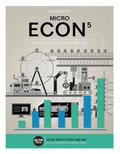
(a)
The amount of pollution discharged if there is no restriction imposed.
Concept Introduction:
The point at which a product’s supply matches or equals the demand is known as economic equilibrium. When the supply of products intersects with its demand hypothetically, the
(b)
The quantity of demand and supply for the restricted discharge.
Concept Introduction:
The point at which a product’s supply matches or equals the demand is known as economic equilibrium. When the supply of products intersects with its demand hypothetically, the equilibrium on price exits.
(c)
Calculate the
Concept Introduction:
The point at which a product’s supply matches or equals the demand is known as economic equilibrium. When the supply of products intersects with its demand hypothetically, the equilibrium on price exits.
(d)
If the quantity of discharge is reduced, calculate the market equilibrium.
Concept Introduction:
The point at which a product’s supply matches or equals the demand is known as economic equilibrium. When the supply of products intersects with its demand hypothetically, the equilibrium on price exits.
Trending nowThis is a popular solution!

- The answer is not Carrow_forwardSocial capital includes: a) labour, produced capital, and natural capital. b) human capital, physical capital, and natural resources. c) labour, physical capital, and human capital. d) labour, physical capital, and produced capital.arrow_forwardGeneral Accounting Question solution and give me Blank ? Carrow_forward
- It is possible to use transformational leadership strategies to reach unethical objectives. Traditional leadership theories and morals standards are not adequate to help employees solve complex organizational issues. For the statement above, argue in position for both in favor or opposed to the statements.arrow_forwardDiscuss the preferred deterrent method employed by the Zambian government to combat tax evasion, monetary fines. As noted in the reading the potential penalty for corporate tax evasion is a fine of 52.5% of the amount evaded plus interest assessed at 5% annually along with a possibility of jail time. In general, monetary fines as a deterrent are preferred to blacklisting of company directors, revoking business operation licenses, or calling for prison sentences. Do you agree with this preference? Should companies that are guilty of tax evasion face something more severe than a monetary fine? Something less severe? Should the fine and interest amount be set at a different rate? If so at why? Provide support and rationale for your responses.arrow_forwardanswerarrow_forward
- Discuss the preferred deterrent method employed by the Zambian government to combat tax evasion, monetary fines. As noted in the reading the potential penalty for corporate tax evasion is a fine of 52.5% of the amount evaded plus interest assessed at 5% annually along with a possibility of jail time. In general, monetary fines as a deterrent are preferred to blacklisting of company directors, revoking business operation licenses, or calling for prison sentences. Do you agree with this preference? Should companies that are guilty of tax evasion face something more severe than a monetary fine? Something less severe? Should the fine and interest amount be set at a different rate? If so at why? Provide support and rationale for your responses.arrow_forwardNot use ai pleasearrow_forwardFor the statement below, argue in position for both in favor or opposed to the statement. Incompetent leaders can't be ethical leaders. Traditional leadership theories and moral standards are not adequate to help employees solve complex organizational issues.arrow_forward
- presentation on "Dandelion Insomnia." Poemarrow_forwardDon't used Ai solutionarrow_forward"Whether the regulator sells or gives away tradeable emission permits free of charge, the quantities of emissions produced by firms are the same." Assume that there are n identical profit-maximising firms where profit for each firm is given by π(e) with л'(e) > 0; π"(e) < 0 and e denotes emissions. Individual emissions summed over all firms gives E which generates environmental damages D(E). Show that the regulator achieves the optimal level of total pollution through a tradeable emission permit scheme, where the permits are distributed according to the following cases: Case (i) the firm purchases all permits; Case (ii) the firm receives all permits free; and Page 3 of 5 ES30031 Case (iii) the firm purchases a portion of its permits and receives the remainder free of charge.arrow_forward

 Essentials of Economics (MindTap Course List)EconomicsISBN:9781337091992Author:N. Gregory MankiwPublisher:Cengage Learning
Essentials of Economics (MindTap Course List)EconomicsISBN:9781337091992Author:N. Gregory MankiwPublisher:Cengage Learning Brief Principles of Macroeconomics (MindTap Cours...EconomicsISBN:9781337091985Author:N. Gregory MankiwPublisher:Cengage Learning
Brief Principles of Macroeconomics (MindTap Cours...EconomicsISBN:9781337091985Author:N. Gregory MankiwPublisher:Cengage Learning Principles of Economics (MindTap Course List)EconomicsISBN:9781305585126Author:N. Gregory MankiwPublisher:Cengage Learning
Principles of Economics (MindTap Course List)EconomicsISBN:9781305585126Author:N. Gregory MankiwPublisher:Cengage Learning Principles of Microeconomics (MindTap Course List)EconomicsISBN:9781305971493Author:N. Gregory MankiwPublisher:Cengage Learning
Principles of Microeconomics (MindTap Course List)EconomicsISBN:9781305971493Author:N. Gregory MankiwPublisher:Cengage Learning Principles of Economics, 7th Edition (MindTap Cou...EconomicsISBN:9781285165875Author:N. Gregory MankiwPublisher:Cengage Learning
Principles of Economics, 7th Edition (MindTap Cou...EconomicsISBN:9781285165875Author:N. Gregory MankiwPublisher:Cengage Learning





